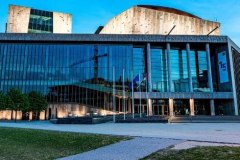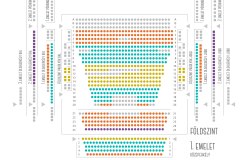Tan Dun
April 2026 | ||||||
|---|---|---|---|---|---|---|
Mo | Tu | We | Th | Fr | Sa | Su |
The Oscar-winning composer Tan Dun’s landmark opera blends Eastern philosophy with the language of Western music. This is the first time the work will be heard in Hungary, and it will be conducted by the composer himself. Set in the 7th century, it tells the story of the passionate love of a Japanese prince and a Chinese princess, and of their fateful quest for the legendary The Classic of Tea by Lu Yu. After its showing in Hong Kong, Csaba Káel’s direction will now be performed before the Müpa Budapest audience with exceptional international soloists such as Lucy Fitz Gibbon, praised by the Boston Globe for her “radiant, virtuosic singing”, and the Japanese tenor Motoki Ishii, renowned for his mastery of the Italian repertoire. The sounds of water, paper, ceramics and stone are transformed into music to create a sensitive and mesmerizing sonic world. Together, the sound and visuals promise a truly unique experience.
Program and cast
Conductor: Tan Dun
Cast:
Lan, princess from the Tang dynasty - Lucy Fitz Gibbon
Seikyo, Japanese prince, monk - Li Sun
prince from the Tang dynasty - Motoki Ishii
Emperor from the Tang dynasty - Apollo Wong
Shadow, ritualist, daughter of Tea Sage Lu Yu - Niru Liu
Featuring:
Hungarian National Male Choir (chorus master: Richárd Riederauer)
Concerto Budapest
Creators:
composer and librettist - Tan Dun
co-author of the libretto - Xu Ying
animation - Dániel Besnyő
director - Csaba Káel
Palace of Arts Müpa Budapest
When Müpa Budapest, Hungary and its capital's new cultural hub, opened in 2005, it was built to represent more than 100 years of Hungarian cultural history. As a conglomeration of cultural venues, the building has no precedent in 20th century Hungarian architecture and has no peers in the whole of Central Europe.
The creators of this ambitious project, the Trigránit Development Corporation, prime contractor Arcadom Construction and the Zoboki, Demeter and Partners Architectural Office, were driven by the desire to create a new European cultural citadel as part of the new Millennium City Centre complex along the UNESCO World Heritage-listed Danube waterfront. The result is a facility whose construction quality, appearance, functionality and 21st century technological infrastructure makes it ideally suited to productions of the highest standard. The building is also highly versatile and equipped to host performances of any genre and almost any scale.

 EN
EN DE
DE IT
IT FR
FR ES
ES RU
RU JP
JP RO
RO
 Seating plan
Seating plan 
